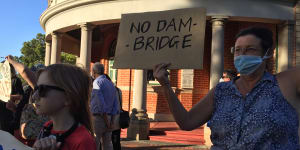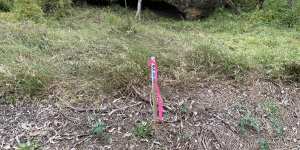But at a City of Swan council meeting on Wednesday night,numerous councillors and community members made a last-ditch attempt to get Main Roads to go back to the drawing board and design a longer-span bridge to minimise the project’s environmental and cultural impact.

Opponents of the Lloyd Street bridge design protesting outside the City of Swan’s council meeting on Wednesday night.Supplied
Opponents of the Lloyd Street bridge project labelled its approval an environmental and cultural failure,and have compared the situation to Rio Tinto’s destruction of the Juukan Gorge caves in 2020,given the bridge will destroy one of the most important sites in Noongar boodja (country) that dates back 29,000 years.
At a City of Swan council meeting on Wednesday night a final attempt to request Main Roads prepare a new concept design with a longer span bridge to minimise the environmental and cultural impact of the bridge failed.
Helena River Alliance spokeswoman Marilena Stimpfl said the project had approval under Section 18 of the Aboriginal Heritage Act 1972,the same law that allowed Juukan Gorge to be destroyed.
Dr Stimpfl said the cultural heritage value of the area included an ancient rock shelter,billabongs and scar trees (trees scarred from Indigenous peoples’ removal of bark to make coolamon and shields or to mark important places).
“Section 18 approvals are fundamentally flawed – this is why the State Government chose to replace them with the new Aboriginal Cultural Heritage Act in December 2021,” she said.
“Many Noongar families have written to council and spoken at meetings to say they do not support the bridge design,including four of the seven Noongar people consulted by Main Roads during the consultation process.
“During the consultation,the Noongar traditional owners repeatedly said they did not want a bridge,but they would accept a bridge,if it was the widest bridge possible,without pylons and without infilling the billabong.
“We have recently found out that none of their requests were accommodated.
“The bridge will be only 54 metres in length,there will be over 150 pylons in the river and the billabong will be infilled and culverted.

Rock shelter near the Helena River.Supplied
“We are not asking for no bridge – we are asking for a better bridge that does not destroy a conservation wetland and a registered Aboriginal heritage site.
“Transport Minister Rita Saffioti needs to explain why she won’t spend the money to protect this site but she will spend money to destroy it.
“It doesn’t make sense.”
Dr Stimpfl said Ken Wyatt had been visibly absent from the debate despite public claims from the City of Swan Mayor and the Swan Chamber of Commerce that Minster Wyatt supported the design.
The Aboriginal Cultural Material Committee considered the Main Roads proposal in February 2021.
It was the WA Aboriginal Affairs Minister who then granted consent for the works on 10 June 2021.
Mr Wyatt declined to respond to WAtoday questions on whether he had had discussions over the concerns of traditional owners,stating the federal government had contributed $20 million to the WA government to work with the council to deliver the project.
“I have been advised that section 18 had been granted for this project,and that the City of Swan and state government were going to proceed,” he said.

Greens senator Dorinda Cox.Supplied
A state government spokesman said the bridge received Aboriginal heritage approval in 2020,during which process the design provided to the government by the City of Swan was amended in response to traditional owners’ concerns.
But at Wednesday’s council meeting,Greens Senator Dorinda Cox,speaking on behalf of three of the seven Whadjuk people involved in the consultation,said the bridge design did not include any of the things they asked for.
“The bridge will still be built in the same place,it will still infill most of the floodplain,the billabong will be buried in a pipe and there will still be pylons in the river,” she said.
“We thought it would be a long suspended bridge connected to the roads that were already built,with very little infill in the floodplain.
“We have now learned that the floodplain will be buried with at least 100,000 metres cubed of infill and 150-plus pylons will be inside the embankments.
“To us,the river includes everything from one bank to the other bank – the floodplain is the same as the river.”
The Whadjuk people said they felt pressured into making a final decision with little time to digest the information presented to them,describing the process as “overwhelming and stressful”.
It left the group feeling as though they were “at loggerheads with Main Roads”,and Senator Cox said the bridge project should be halted.
“If this project was presented under the new legislation[passed in December 2021],given the information I have about its suggested improvements to protect Aboriginal cultural heritage – I guarantee it wouldn’t meet the requirements and that has been the problem all along with Section 18s,” she said.
“The report on Juukan was pivotal,it shone a light on industry and its destruction of our cultural heritage and our environment.”
She called on the government to halt the project using a sunset clause under Section 18.
“If the state government are serious about their relationship with traditional owners they should scrap all existing Section 18s and enact the current legislation to enable the Local Aboriginal Cultural Heritage Plan to be developed as per the new legislation,” she said.
“Is this piece of infrastructure so important that we are willing to desecrate a significant cultural and environmental site;and have we all exhausted all other avenues?”
The state government spokesman said one-in-100-year flood modelling showed the bridge would have a “negligible” impact on the flood plain.
A redesign that significantly changed the scope of the project for a longer bridge structure,would mean piers,he said:“our advice is piers into the river would not be acceptable.”
“Such a project is likely to exceed the current cost estimate by tens of millions of dollars,” he said,noting current approvals – including Aboriginal heritage approval – would become invalid.
“The state was undertaking this project on the request and on behalf of the City of Swan. There have been briefings and consultation along the way,” he said.
“If the City of Swan wants to walk away from decades of proper planning,and expose its ratepayers to significant cost that is up to them.
“They will need to source the extra funding,and start the approvals process from scratch.”
The City of Swan had been working to progress the bridge project for more than 20 years to create a new entry into the rapidly growing region and reduce the traffic gridlock through Guildford.
Main Roads provided the Lloyd Street bridge concept design to the city for endorsement as part of its wider plans for the $380 million Great Eastern Highway Bypass Interchanges project due for completion in 2024.
In a report to council ahead of the vote,staff warned a redesign of the Lloyd Street Bridge would cause delays,prove costly and may result in the bridge being removed from the overall Bypass Interchanges project.
The Morning Edition newsletter is our guide to the day’s most important and interesting stories,analysis and insights..